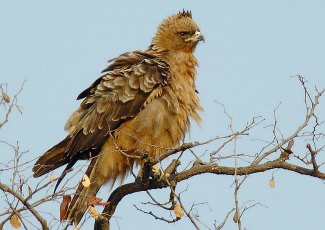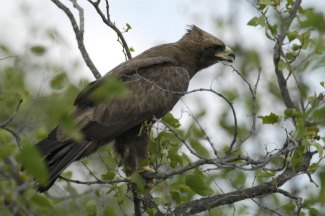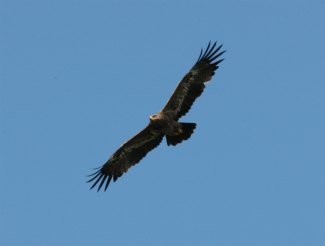Wahlberg's Eagle - Aquila wahlbergi
By Doug Newman, Public domain, via Wikimedia Commons
Family: Accipitridae
Genus: Aquila
Species: A. wahlbergi
Wahlberg's Eagles are small raptors that live in a range of habitats across Africa. They form a clade with Aquila ayresii (Ayres's Hawk Eagle), A. morphnoides (Little Eagle), and A. pennata (Booted Eagle).
Physical Description:
There are several morph forms of Wahlberg’s Eagles. Dark morphs are rufous to dark brown with pale edges along the wing-coverts, head, and underside. Rare pale morphs are white except for gray-brown wing-coverts, scapular feathers, and back, and a black tail and flight feathers. Intermediates are light brown, buff, or rufous with varying combinations of dark and pale morphs. All Wahlberg’s Eagles have a gray undertail and pale primary feather bases. The eyes are dark brown and the cere and feet are yellow.
Juveniles are similar to adults, except for greater pale edges on the wing-coverts and heavier streaking along the head and neck.
They are quiet birds, except when around the nest. Their main call is a shrill, whistling "kleee ee" or "kleee ay".
Size:
Length: 53-61 cm
Wingspan: 130-146 cm
Weight: Male: 437-845 g. Unsexed Aquila wahlbergi: 670 g-1.4 kg.
Habitat and Distribution:
They live in woodland, wooded savannah, grassland, and cultivated areas, often close to rivers. They avoid dense forest and arid regions and prefer flat terrain as opposed to hilly and mountainous regions. Wahlberg’s Eagles are found from 1,800-2,800 m above sea level.
By pimgmx, CC-BY-NC-2.0, via Flickr
They are found in different areas of Africa based on the breeding season and the rainy season. Their main breeding areas are in sub-Saharan Africa along Kenya, Tanzania, and the Democratic Republic of the Congo and south of that to northeastern South Africa, in addition to Uganda, Ethiopia, southern Sudan, Senegal, and Gambia. Most adults are long-distance migrants, arriving in their southern range during August-September and leaving in March-April. In eastern Africa they move south in July-August and breed along the equator. Some eagles may be sedentary, nomadic, or short-distance migrants along the equator, remaining in the same general area year-round. There are an estimated 100,000 individuals over a range of 12,600,000 km².
Diet and Hunting:
Wahlberg’s Eagles eat reptiles, mammals, and birds, in roughly the same proportions, taking ground lizards, snakes, small rodents, hyraxes, bats, larks, guineafowl, bustards, owls, and nestlings, among others. They are also known to hunt amphibians and insects such as beetles, grasshoppers, and termites.
Most of their prey is taken on the ground, though they will chase birds in flight. They still-hunt from a perch, follow grass fires for insects, and are known kleptoparasites, having been observed stealing food from Lophaetus occipitalis (Long-Crested Eagle). One pair fed their chicks on herons and egrets alone using cooperative hunting: one eagle forced the heron and egret parents to flee the nest while the other attacked the nestlings.
Reproduction:
Breeding displays are short and consist of circling, claw-grappling, and sky dances. The breeding season is from September-February, except in eastern Africa where they breed from July-November. Pairs are monogamous.
The nest is usually 45-80 cm across and 25-60 cm deep and lined with green leaves. It is placed 8-12 m up in the canopy of a baobab, acacia, eucalyptus, or other tall tree, often close to water. 1-2 eggs are laid, usually 1, and incubated for 44-46 days. The eggs have a variety of markings, from being pure white to having dark and rufous blotching. Fledging takes 62-80 days, most frequently 70-75.
By michaelandhelencox, CC-BY-NC-SA-2.0, via Flickr
Conservation:
They are one of the most common eagles in sub-Saharan Africa, and though poisoning and hunting are threats, their population hasn’t declined in decades. Wahlberg’s Eagles are currently listed as Least Concern by BirdLife International.
Taxonomy:
Aquila wahlbergi is considered a sister species to Aquila ayresii (Ayres's Hawk Eagle), A. morphnoides (Little Eagle), and A. pennata (Booted Eagle), based on the DNA sequences of one mitochondrial and three nuclear genes.
The scientific binomial name Aquila wahlbergi comes from Johan August Wahlberg, a Swedish naturalist who was posthumously elected to the Royal Swedish Academy of Sciences.
Other Names:
Bruinarend (Afrikaans), Savanneørn (Danish), Wahlbergs arend (Dutch), Sirokotka (Finnish), Aigle de Wahlberg (French), Silberadler, Wahlbergadler (German), Aquila di Wahlberg (Italian), Himeinuwashi (Japanese), Bantuørn (Norwegian), Orzel afrykanski (Polish), Águila de Wahlberg (Spanish), Tai Msafiri (Swahili), Wahlbergs örn (Swedish), Ghama (Tsonga).
Video of a Wahlberg's Eagle Nest:
References:
http://www.arkive.org/wahlbergs-eagle/aquila-wahlbergi/
http://avibase.bsc-eoc.org/species.jsp?avibaseid=535F3C994BB4A618
http://www.biodiversityexplorer.org/birds/accipitridae/aquila_wahlbergi.htm
BirdLife International (2012) Species factsheet:Aquila wahlbergi. Downloaded from http://www.birdlife.org on 12/04/2012.
Global Raptor Information Network. 2012. Species account: Wahlberg's Eagle Aquila wahlbergi. Downloaded from
http://www.globalraptors.org on 12 Apr. 2012
http://www.guardian.co.uk/science/punctuated-equilibrium/2010/nov/12/3
http://ibc.lynxeds.com/species/wahlbergs-eagle-aquila-wahlbergi
BirdLife International 2009. Aquila wahlbergi. In: IUCN 2011. IUCN Red List of Threatened Species. Version 2011.2.
www.iucnredlist.org. Downloaded on 12 April 2012.
http://www.planetofbirds.com/accipitriformes-accipitridae-wahlbergs-eagle-hieraaetus-wahlbergi
Ferguson-Lees, James, and Christie, David A. Raptors of the World. Houghton Mifflin Company, 2001.


